- Home
- Injections
- Laser Treatments
- Specialties
Specialtiesview all
- Other Treatments
- Before After Photos
Before After Photosview all
- Contact Us
- Doctor And Staff
- About Celibre
- Blogs
We often hear this question, and our response is that it varies. It depends on the type of hair you have, the type of skin you have, the amount of area to be treated, and the laser to be used. We would rather see the patient in person to determine the price because it helps us set proper expectations regarding the cost, number of treatments, and expected outcome. With that said, it may be possible to compare prices for laser hair removal facilities, but our caution would always be to find a practitioner with lots of experience with the procedures and the right type of laser for your skin type.
Laser hair removal before and after pictures
One of the main mistakes consumers make when choosing a practitioner for laser hair removal is that they shop for the cost of a single treatment rather than considering the total cost of laser hair removal. The total price for laser hair removal is the cost per treatment times the number of treatments. Also, it is implied when a potential patient asks us how much laser hair removal costs, that they believe that no matter which facility they go to, that the ultimate results will be the same.
This could not be farther from the truth. When a facility prices their procedures very low, they have to cut costs any way they can. Cutting back on training or expertise by hiring inexperienced nurses is one way. Using inferior and cheaper lasers is another way. And finally, a third is to rush the patient through treatment by not taking as much time or covering as much area. All of these cost cutting strategies can lead to worse outcomes, more treatments required and/or less hair removed.
Our advice to our patients and consults alike is to do lots of research. Find out what others are saying about the facility, which lasers they have and how much experience the nurses or physicians performing the treatments have. Lastly, go to several consultations. We’ve found that our patients value the trusted relationship we develop with them and the results that we deliver. The old saying “you get what you pay for” will go a long way in determining the question – what is the price for laser hair removal?
Lori Ishii Haney, RN, MEP-C
Certified Medical Laser Safety Officer
As experts in laser hair removal, we can tell you that not all laser hair removal programs are equal. At Celibre Medical, we have developed proven, effective laser hair removal treatment programs that allow our patients to enjoy between a 75% and 95% permanent reduction of their unwanted hair. In our experience, this level of hair removal is usually achieved after 6 to 8 treatments.
We’ve developed some common recommendations that we give to each patient to help get the most out of their laser hair removal treatment. We ask that you keep all your regularly scheduled appointments, to stay on the correct time interval between treatments. We also ask that you shave to removal unwanted hair during your treatment. Plucking or waxing removes the hair from the follicle, so that laser becomes much less effective at damaging it.


Permanent Laser Hair Removal Before and After Pictures
While most patients enjoy excellent results in 6 to 8 treatments, some see the same level of improvement after only 4 treatment sessions. The bottom line is that there is some variability, but if you’re not seeing a significant reduction in the amount of hair after 2-3 visits at your practitioner’s office, it may be time to switch. And if you’re pressured to sign up for a 6 or 8 treatment “package”, resist the urge. If you sign up with the wrong practitioner, you may not be able to get a refund.
Finally, we have identified a few different factors that may lead to more than the recommended number of treatment sessions. Hormone imbalances (like PCOD) and fine hair or hair that is light brown (not dark brown or black) will usually require more treatment sessions to get optimal results. We have also found that certain ethnic groups generally require more treatment sessions as do large areas, like the back or the legs.
We believe in being up front with our patients and educating them thoroughly about their procedure prior to beginning treatment. We’ve found that preparing you for the road ahead not only makes for a happier ride, but also gives you greater satisfaction at the end.
Permanent makeup is just like any other tattoo – sometimes your tastes and preferences change, and you decide that you no longer like it. If you fall into this category, it’s okay! We’ve helped thousands of people just like you who want their permanent makeup removed with laser treatment. The process is almost exactly the same as laser tattoo removal, and the delicate facial skin can be safely and effectively treated with lasers to remove permanent makeup.

One question that we are often asked is will the laser change the color of the makeup. We have seen this happen before and unfortunately, we don’t know who it will happen to prior to laser treatment because it all depends on the type of ink that was used. We can tell you (and will before we ever do your first treatment) that if a color change occurs, it happens immediately after laser treatment. The process that triggers the change is called oxidation/reduction. This is a fancy term that means the ink particles undergo a physical change during treatment, very similar to what happens when a car rusts.

Often, ink that is closer to an orange color prior to laser will darken to a grey color (see photo). But this isn’t really a bad thing, because darker colors are typically more responsive to laser treatment, so it’s often a help, not a hindrance. While other color changes are possible, you can rest assured that no matter what the color, we have a laser that can safely and effectively treat your unwanted permanent makeup.
We’ve been removing permanent makeup with laser treatment since 2008. We’re experts in the field and we’ve seen pretty much everything! Most importantly, we’ve helped our patients look and feel better about themselves and we can do the same for you.
Very simply, yes you can get rid of Poikiloderma. Here at Celibre Medical, we have a wide array of FDA-approved class IV medical lasers and broad band light that can both safely and effectively remove the red and brown discoloration of Poikiloderma. We use pulsed dye lasers, q-switched lasers and the Sciton BBl (broad band light) to get rid of redness, sun damage and uneven skin tone.
A good question to ask is, “Will my Poikiloderma stay gone after laser treatment?” This question is a bit more difficult to answer. One factor to consider is how you developed your Poikiloderma in the first place. Chances are you spent a lot of time in the sun. UV exposure is the main culprit behind the changes that you see on your skin.
So, if you decide that you’re going to invest the time and make the financial commitment to get rid of your Poikiloderma with class IV medical lasers, then you need to take the proper steps to make sure that you protect your skin so that you don’t develop it again.
Sun avoidance works as the best type of sunscreen. Do your outdoor exercise or yard work early or late in the day, when the sun’s UV isn’t quite so intense. Even still, you must wear broad spectrum sunscreen to protect your skin from damaging UV rays, and consider protective clothing if you’re going to have extended periods of sun exposure, especially if you’re swimming or sweating.
At Celibre Medical, we’ve helped many patients rejuvenate the appearance of the skin on their neck. We can help you too. Don’t hide behind your turtlenecks any longer. With the proper laser treatment and some simple, yet effective sun-smart behavior, you can be proud to show it off again.
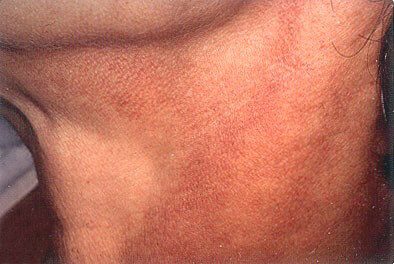
Poikiloderm photo (courtsey of eMedicine)
You can find laser hair removal in almost every city in America. Dermatologists, plastic surgeons, OB/Gyns and family practice offices offer it? But who’s qualified to do laser hair removal and how can you ensure you’re getting an effective treatment?
You may not be surprised to learn that price isn’t the most important factor! Understanding the available devices and which one is right for you is really the first thing you need to consider when choosing your laser hair removal provider.
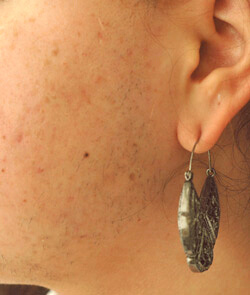
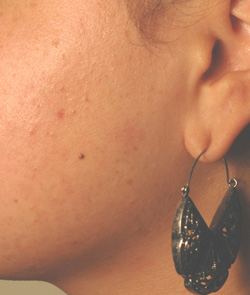
Laser Hair Removal before and after pictures
Let us explain a bit more. First, you need to know what your skin type (color) is. There are six different skin types: type I to type VI. We’ve listed them along with a description below for you:
Now that you understand your skin type, let’s talk about the different laser hair removal devices. Each of these is specific for a certain range of skin types. This should help you decide which class IV medical laser is the right choice for laser hair removal. There are three, different devices currently available:
The diode laser is the most common laser hair removal device used today. The Lumenis LightSheer is a brand of diode laser considered the “gold standard” for laser hair removal among medical laser professionals. It is ideal for skin types I through IV. And although the manufacturer advises that it may be used on higher skin types (with certain models), our experience has not shown this to be true. We would strongly caution those with a skin type V or VI against having laser hair removal with this device.
The Alexandrite laser is a less commonly used device, but still very effective for laser hair removal in skin types I through III. We generally would not recommend its use in anyone over a skin type III due to the risk of hyperpigmentation or darkening of the skin and blistering. There are several brands of Alexandrite lasers, but the Cynosure Apogee is the most widely used device in this category.
Lastly, the Nd:Yag laser is the type of device that is most commonly used laser hair removal device for darker skin types (type V and VI). What makes this device safe for dark skin? Remember that laser hair removal works by damaging the follicle with heat (or light) energy. All the lasers listed above target melanin which is the pigment that lines the hair follicle and gives the hair color. Since people with black skin have a lot of melanin in their skin and hair, special laser technology must be used to properly target the melanin in the follicle while avoiding it in the skin. At Celibre, we use a device called the Sciton Profile.
The Sciton Profile is a long-pulsed Nd:Yag laser that uses a greater penetrating wavelength of light that can get to the deeper melanin in the follicle and bypass the melanin closer to the skin’s surface that gives it color. This device is extremely safe for all dark skin types and works very well for laser hair removal in black skin.
Before you consider laser hair removal, take a moment to familiarize yourself with the most common types of lasers. This will help ensure a better outcome with more permanent hair removal for you.
If you’ve got ingrown hairs, you know that they not only look bad, but they hurt too! These painful, tender, red, raised bumps are common on the face, scalp and body usually after shaving. Ingrown hairs can be mistaken for acne, lead to more severe skin problems like folliculitis (infection of the hair follicle) and they can also lead to permanent facial scarring. Darkened areas of skin, known as traumatic hyperpigmentation can take months (or longer) to resolve. And a more serious form of ingrown hairs called pseudofolliculitis barbae can lead to permanent raised or pitted scars in the beard and neck.
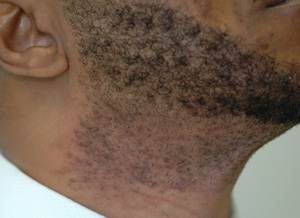
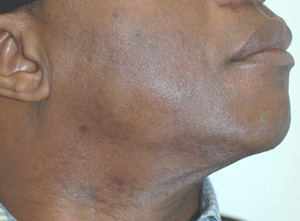
Laser hair removal before and after photos
There are many over-the-counter products including shave creams that promise to reduce or even eliminate ingrown hairs, but for many of us, they just don’t work. However, there is one, proven way to eliminate painful, potentially scarring ingrown hairs once and for all: laser hair removal.
Laser hair removal is safe for all skin types (colors) and can be performed anywhere on the body. It is the perfect treatment for this common, frustrating problem. Why shave day after day and risk serious skin infection and scarring when you can permanently get rid of your unwanted hair? Many of our patients who’ve experienced the scarring type of folliculitis find that once the hair is gone for good, their skin settles down and returns to a more normal appearance.
If you’re suffering with ingrown hairs and frustrated with the previous products and treatments that didn’t work for you in the past, consider laser hair removal. It truly is a miracle treatment that can keep this problem at bay for you permanently! It is safe and effective no matter where you’re bothered by ingrown hairs and no matter what skin type (color) you have.
When done correctly, laser hair removal lasts forever. Permanent hair removal is the end goal, and in our practice, permanent removal of 75% – 95% of the hair with color and coarseness is typically achieved in 6-8 visits.
There are several factors that help determines How Long Does Laser Hair Treatment Last and whether or not it is permanent.
The type of hair is important as permanent hair removal only lasts forever when the hair we are treating has color (blond, white and red hair do not respond well). Black and brown hair work well and the thicker the hair is, the easier it is to get permanent results. On the spectrum of hair types, laser hair removal of blond fine hair (such as peach fuzz) does not work and permanent removal of thick, dark hair is fairly straightforward. The thicker and darker the hair, the more permanent the laser hair removal results you will achieve.
Different skin and hair types are better suited for different types of lasers, so if you want your laser hair removal to last forever, make sure to do a bit of research on which lasers would work well with your skin type. Generally speaking, for skin types I-IV (Scandinavian up to Asian, Middle Eastern and Hispanic) the Diode and Alexandrite lasers are typically used. For darker skin types V and VI (African-American and African), the Yag laser is the best choice.
The more procedures your laser hair removal practitioner has done, the higher chance you will have at getting lasting results for your treatments. Many consumers believe that laser hair removal is the same at every practice. Nothing could be further from the truth. The way the procedures are performed (energy level used, areas covered, etc.) will affect your results.
When choosing a laser hair removal practice, make sure they have experienced physicians, nurses or technicians, and laser technology that is appropriate for your skin type. Know yourself that if you have thick dark hair you are an excellent candidate and if you have blond, fine hair, you will be disappointed with the results. If you are a good candidate and find a great practice, your laser hair removal results can last forever.
Generally speaking, yes, laser hair removal is uncomfortable. But if that’s what’s keeping you from considering having treatment, then perhaps you should reconsider? Everyone’s perception of pain is different, and we feel like we have identified a few factors that are correlated with an increased amount of pain with laser hair removal. If you don’t fall into one of these groups, maybe it is something that you should think about doing! If you are in one of them, we suggest you try at least a single treatment. Often patients will tell us that the pain of laser hair removal was more a figment of their imagination than a reality after they’ve gone through a treatment or two.
Through our unofficial research, we’ve found the following factors generally point to increased pain with laser hair removal: thick, dark or coarse hair; young age; and male gender. Let’s go into each of these briefly:
Thick, dark, coarse hair is a “target rich” environment for the laser. These follicles are larger and they contain more melanin or pigment, which is what the laser’s energy is drawn to and absorbed by. So naturally, people with this type of hair will feel the laser more. But on the flip side, that sensation tells you that the laser is working! This type of hair responds the best to laser hair removal.
Because the follicle must heat up to the point where it becomes structurally damaged and can no longer grow hair. The larger the follicle and the more “target”, the more heat absorption which produces the sensation or pain, but the better the results too!
The good news is that thick, dark hair disappears quickly, so pain typically diminishes with each subsequent laser hair removal treatment.
Younger patients tend to tell us that laser hair removal is more painful. Why? We aren’t totally sure, but maybe it has something to do with not having experienced much pain previously in life (those reading who are older can appreciate this). If you’ve gone through childbirth, a surgery or injury, then you have some experience with pain. Younger folks maybe just haven’t gotten in on all the fun yet! We also wonder if older patients are more committed to getting rid of their unwanted hair. They’ve shaved, waxed, tweezed and plucked to the point where they don’t care how much it hurts; they just never want to have to groom themselves again!
Men seem to tolerate the discomfort of laser hair removal less than women. We again can only speculate as to why, but possibly it’s because they tend to have thicker hair than women, so perhaps they really do feel it more? Or perhaps the societal pressure on women not to be hairy is so much greater for a woman than a man, that again, women don’t care how much it hurts—they just want the hair gone once and for all!
Remember, not everyone struggles with discomfort during laser hair removal. Pain is a highly individualized sensation, so you really don’t know how it will feel to you until you try it! At Celibre, we treat everyone with the same respect; and we take all measures we can to ensure that you are comfortable and can tolerate your laser hair removal procedure. We use topical numbing creams, ice packs and cold air to help ease your discomfort and get you through the procedure.
As the leader in laser hair removal in Southern California since 2004, we will tell you that during that time only a few patients have opted out of having laser hair removal with us because of pain. We encourage you to give it a try and see how it goes! We know you won’t be disappointed with your results!

* View Some of our Laser Hair Removal Before and After Pictures
If you’re considering laser tattoo removal to get rid of an unwanted tattoo, you might want to know what lasers work well. Laser tattoo removal can be a bit of a complicated thing; no doubt you’ve come across a lot of information and are a bit confused about what laser might be best for your tattoo.
We want to discuss with you the top three lasers that are used for laser tattoo removal. The first part of this article discusses the type of laser technology. These names are generic for the type of laser (not brand). The second list includes will name brands of each type (think Kleenex, Puffs, etc.). Putting these two lists together will help you as you shop around and research the best laser practice for your tattoo.
First, here are the generic laser types. This lasers may have different brand names, but that they all incorporate one (or more), specific wavelength(s) of light to remove specific colors of tattoo ink:
Now, onto the specific brands of these lasers:
So, remember when considering laser tattoo removal that both the type and brand of lasers matter in determining the result of your treatment.
It’s never been easier or more socially acceptable to have a tattoo than today. Everywhere you look from professional athletes and celebrities to doctors, lawyers and teachers, you can find people from all different walks of life with one. And while many people choose tattoos to commemorate or celebrate something near and dear to them, some people simply get them on a whim only to regret their decision later. The good news is that it’s never been easier to get a tattoo removed—that is, if you don’t mind spending a little extra time and money in the process.
Laser tattoo removal has become immensely popular in the past few years because it’s the only option available to who no long want to live with a tattoo. But it’s much harder to get one removed than it was to get one put on in the first place! This is because the laser isn’t actually doing the work of getting rid of the tattoo ink. Your body is! The laser is just there to help your body work a bit more efficiently at what it does naturally.
You see, our bodies are designed to remove foreign things like bacteria, viruses and even suture material. Tattoo ink is a foreign invader in the skin and your body will try to remove it over time. The tattoo ink particles are too large for our body to do this very well on its own; that’s why tattoos often fade as they age instead of disappearing. They are under constant attack from our body’s immune system. Enter lasers. Q-switched lasers to be specific. These lasers use a high energy pulse delivered over a short duration of time to help break up the ink particles into something the body can get rid of more efficiently on its own.
Q-switching is a unique function of a laser and not every laser is capable of it. If you’re considering laser tattoo removal, it should be with a q-switched laser to give you the best results. There are different energy sources for q-switched lasers that give them different wavelengths of light which are attracted to different colors of tattoo ink. Also make sure that your laser practitioner is using a q-switched laser that is safe for your skin type, as there are some that cannot be used on darker skin.
Lastly, remember that the laser is an important piece of the equation for effective treatment, but if it’s in inexperienced or incapable hands, you may not see the results you’re looking for, or worse yet, you could experience an unwanted side effect such as scarring or permanent loss of pigmentation. Find out what kind of expertise and experience your laser practitioner has before you assume they know how to treatment tattoos with lasers.
Generally speaking, there are four types of commonly used lasers for permanent hair removal.
Having performed tens of thousands of laser hair removal treatments since 2004, we’ve had the opportunity to use a fair number of laser hair removal devices. The answer to the above question may not be as simple as it seems. Generally for lighter skin types, the best TYPE of lasers are the Diode and Alexandrite. For darker skin types (specifically African), the most appropriate laser is the Yag. But in Los Angeles, we have a wide variety of skin types and mixes and sometimes an African American mix may be more appropriate for a Diode than a Yag. The last device (IPL) is not a laser and is instead a device that uses a mix of wavelengths of light. Because of this, IPL is less effective at ensuring permanent hair removal. In addition, it has a higher incidence of side effects than lasers do. For this reason, we do not recommend IPL for laser hair removal.
There are many, many different brands of laser hair removal devices. What consumers should focus on is not so much the brand (Lumenis, Palomar, Candela) but rather the wavelength of light (Diode, Alexandrite or Yag) and whether the laser is appropriate for their skin type. Also important is the experience of the laser practitioner. Regardless of which laser hair removal technology is used, if it is not used well, you may not achieve a high % of permanent hair removal. Your best bet is to ask a friend who was successful with their laser hair removal program where they went or check online reviews.
We understand that if you’re shopping around for laser hair removal services, you want to make sure that you get the very best treatment for the lowest price possible. If you’ve spent some time browsing this subject on our site, then you understand there are many factors that affect the price of a laser hair removal treatment. One of those is the type of equipment or the laser hair removal device used.
You may not know there are several different, yet effective, devices out there for effective laser hair removal. The best one for you depends on your specific skin type or color. If you have a lighter skin type—like Caucasian, Hispanic or Asian, East Indian or Filipino, then the Lumenis LightSheer is an excellent choice for you.
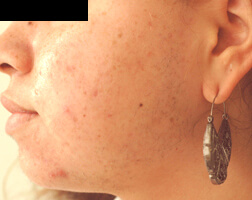
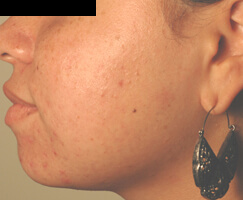
Laser hair removal before and after pictures
The Lumenis LightSheer laser has been the choice for thousands of laser hair removal practices the world over. Tens of thousands of these devices have been purchased and continue to perform as a workhorse of those who provide laser hair removal.
The reason the LightSheer works so well is that the wavelength of light it uses (810 nanometers) penetrates to the perfect depth to reach the base of the hair follicle. During treatment, the heat from the laser compromises the hair follicle’s blood supply so that it can no longer generate hair. This very particular wavelength and it’s high absorption by hair means that more energy goes into the target and very little is absorbed into other skin tissues. Not only does this make the LightSheer more effective, it makes it safer too as it reduces the risk of unwanted side effects.
We proudly offer laser hair removal services with this device at Celibre Medical. We know that this laser is not only effective, but consistent and trustworthy. For patients with an appropriate skin type, it is by far our first choice for laser hair removal anywhere on the body. We choose our devices based on performance, safety and market reputation—not simply cost. We let our patients know this because we believe it’s important for them to do the same when choosing a laser hair removal practice and practitioner.
We know that trying to make heads or tails of all the laser information out there can be difficult if not impossible for the average person. The recent advances and breakthroughs in laser medicine are amazing and the number of devices and the companies that market them has skyrocketed in recent years. One of our guiding principles is patient education. We believe in providing the highest level of patient care, and to accomplish that, educate our patients on all aspects of their care.
One of the most frequently asked questions that reinforces our dedication to this end is what are the main differences between [laser A] and [laser B]? And often, as is the case with Coolbeam or “Cool laser” as it’s also called, we often educate our patients about devices that we don’t use ourselves. To discuss this device with our patients, we sought out a local provider that uses it to have them educate us on what it is, how it works and what its used for.
The Coolbeam laser is a type of fractionated erbium laser used for resurfacing the skin in procedures such as facial rejuvenation, stretch mark removal and improving acne scars. A similar laser that we use at Celibre is the Sciton Profractional. It is also a fractionated erbium laser that we’ve used successfully to treat many of the same conditions.
Since we’ve never actually laid hands on a Coolbeam laser, we can’t discuss the subtle differences between it and our Sciton laser. But since the two are very similar technologies that use the same type of energy source, they are fundamentally very alike. We can discuss the results that we’ve achieved with the Sciton laser and share some actual patient photos with you like those on this page. As you can see, it’s very effective for the treatment of unwanted acne scarring.
Whichever device you choose for your treatment, make sure that you ask about the technology itself in addition to the cost. Understanding the potential risks and benefits of any procedure along with what you can expect in terms of improvement and downtime will go a long way toward being happy with your treatment!
Over the past several years, it has become more commonplace to treat patients for non-surgical nose shaping. In many cases, the patient does not necessarily have an issue that is well suited to surgery, or the patient does not prefer surgery for one reason or another.
We use Radiesse in situations where a patient prefers non-surgical nose shaping. An example of the work is below for “Asian Nose Shaping”. This patient was trying to achieve a straighter line between the forehead and mid nose (at the bridge). We added Radiesse to the area so that she did not have such a concave shape at the bridge.
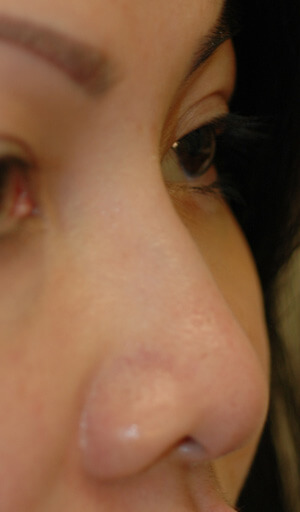
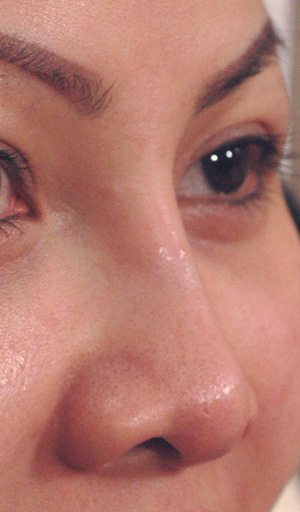
Are you considering laser hair removal, but are hesitant because you’re worried about side effects? That’s okay! We understand and we want you to know that even though it seems like laser hair removal is done everywhere by everyone, it’s good to have a healthy respect for it and a tiny bit of concern too. Lasers are powerful tools that in the wrong hands can cause negative consequences!
In order to understand why side effects occur with laser hair removal, you need to understand what’s actually happening during treatment. Laser hair removal works by transferring thermal energy from the laser to the hair. We have other pages that detail the exact process of laser hair removal, but to understand what you read here, know that the heat is what does the work.
During a normal laser hair removal treatment, the goal is to transfer enough heat to the hair follicle to damage it enough so that it won’t continue to grow hair, but not too much that it spills over to the surrounding skin. One of the ways we measure this is by how your skin reacts after it’s treated with the laser. One of the tell-tale signs that all is going well is something called “follicular edema”.
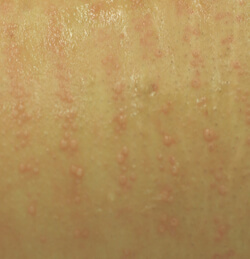
Follicular edema looks a lot like hundreds of little ant bites on the skin. In fact, that’s the term that we used here at Celibre to describe the phenomenon. Basically, after the heat is transferred to the follicle, it swells. You will see this reaction almost immediately. It usually happens in areas where your hair is thickest.
While we don’t really think of these bumps as a side effect, most patients do. It can look a bit scary as you can see in the photos here. Another important fact is that they can last for a couple of days—and that’s very normal! You will need to be careful not to shave in the couple days following the treatment as it is sensitive. It may feel a bit uncomfortable too, so you may want to use hydrocortisone cream or treat it with cool compresses to soothe it.
Along with follicular edema, redness is also a common (and good) sign after laser hair removal. It is a typical and expected response to the thermal energy that’s been delivered to your skin. Most people find that the redness resolves in anywhere from 30 minutes to 24 hours after treatment.
Now, let’s talk about what’s not normal and what you DON’T expect to see after your treatment. Laser hair removal should never burn or blister your skin. This reaction means that the thermal energy has “spilled over” into the surrounding skin and triggered these changes. There are a few different reasons why this happens:
As commonplace as laser hair removal seems, remember that it is a procedure that has some risk. Make sure that you have a complete consultation prior to treatment day and ask all the important questions such as what device will be used and how much experience your laser practitioner has. If you’re still not sure what else you need to know, please check out our questions to ask during your laser hair removal consultation page.


Laser hair removal before and after pictures
Contact us today to schedule a FREE consultation! 

